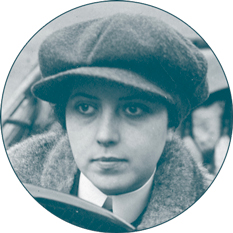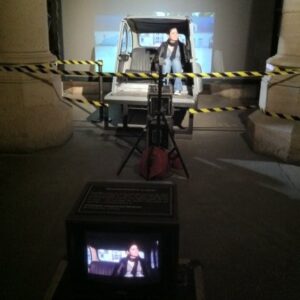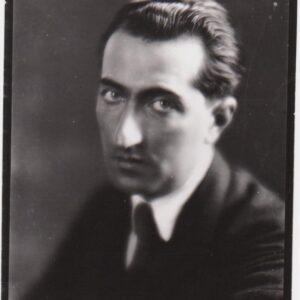
Laurent Véray
Professor at the department of cinema and audiovisual studies, Université Sorbonne Nouvelle – Paris 3
Over the past forty years, major research programs in film history have mainly focused on the period when the cinematic medium first emerged and on the cinema of attractions that characterized that era.
Other studies have pointed out the crucial role of the 1910s: a period of institutionalization that saw the establishment of the economic and industry structures of cinema as we know it today. Besides the system of renting copies and the development of specialized cinemas, the standardization of production according to the Pathé model was a turning point in the way films were made and received, in conjunction with the general development of narrative films. This was how the classical conception that still governs most audiovisual productions first emerged, using editing to represent space and time continuously and construct a narrative. However, this transition to classical cinema – and the decisive contribution of the years from 1908 to 1919 to the industrialization of the medium in France and across the world – has yet to be studied extensively. This is the goal of Ciné08-19. One of the project’s main hypotheses is that the period studied represents a decisive moment in the evolution of cinema within an emerging cultural industry.
As first step, the project has carried out an exhaustive survey of the conditions in which films in France and its colonial empire were written, produced, directed, distributed and received. Second, the project has considered this period in depth through a detailed, heuristic exploration of multiple sources, both film and non-film, many of which were still inaccessible until recently. These two lines of investigation come together on the project’s digital platform, highlighting connections between the wealth of digitized materials while at the same time sharing analyses of these collections with a large audience.
A distinguishing feature of Ciné08-19 is its interdisciplinary, multi-regional team, made up of researchers from six universities (Bordeaux Montaigne, École nationale des Chartes, Gustave Eiffel, Lille, Metz, and Sorbonne Nouvelle, which hosts the project) and representatives, curators and archivists from participating cultural institutions (Centre national du cinéma et de l’image animée, Cinémathèque française, Établissement de communication et de production audiovisuelle de la défense, Musée Albert-Kahn, BnF, BHVP, Gaumont-Pathé Archives).
One of Ciné08-19’s main features is not only rethinking the relationship between film and non-film archives and their users by means of digital tools, but also presenting the project’s knowledge and results to a wider audience.
Our research began with the following observation: although vast collections of archives, some digitized, others not, are gradually becoming available to researchers, they are only rarely studied. Because of this, we felt it was necessary to carry out an in-depth, heuristic investigation of this pivotal period through a detailed exploration of these multiple sources. Our approach aims to demonstrate both the unique features of the film market in France as well as the wealth and diversity of cinema between 1908 and 1919; we rely on analyses of a wide range of sources and a collaborative methodology based on our consortium’s presence across multiple institutions. An essential distinction among our sources is between film and non-film documents. While the former—negative and positive (housed at the CNC, the Cinémathèque française, the ECPAD, the Musée départemental Albert-Kahn and Gaumont-Pathé Archives)—are obviously to be expected, many have gone unseen for decades and are able to shed light on the nature of the era’s fiction and non-fiction. The non-film sources have been explored even less, in part because they were previously scattered across multiple archives in public institutions and private collections. Partially digitized, they are now available and contain an abundance of information in many forms: administrative and economic data, company catalogs, producers’ and filmmakers’ correspondence, a variety of screenplays, camera operators’ notebooks, studio photographs, local, sub-local and national press clippings, movie theater programs, posters and advertising material, security and censorship documents, and more.
The approaches used to study and compare these collections involve distinct fields including history, aesthetics, sociology, economics, anthropology, genetic studies and narratology. Moreover, our interdisciplinary research extends beyond the Paris area, since France’s regions, as well as former colonies, in all of their diversity, were centers of production and distribution that each had their own distinctive features.
In addition to transmitting knowledge by traditional means (through conferences, colloquia, books, and academic articles), we have placed emphasis on creating an online platform. The establishing of connections between film history sources brings with it new theoretical questions and innovative practices that determine how our resources are used by scholars as well as the way this period’s history is presented. The Ciné08-19 platform allows for both of these dimensions in its publication of editorial content. It is interconnected with the CNC’s Garance platform, the ECPAD’s Images défense site and the Musée Albert-Kahn’s Archives de la Planète portal, as well as Gaumont Pathé Archives’ site on Gaumont productions of the silent era.
With this bilingual (French and English), interactive, adaptable tool, it is possible to compare and contrast film and non-film documents, as well as to produce filmographies including references and analyses that can vary according to the target audience. The Ciné08-19 platform was designed according to specifications developed by Armâne Magnier, a digital humanities student at the École des chartes, during an internship funded by our ANR project. Built by Jérémie Bancilhon and Go On Web, the Ciné08-19 platform is hosted by Huma-Num to ensure its long-term stability.
The goal is to make photographic and film collections available to researchers (edited films, but also rushes, including films from different countries that were produced, directed and/or exhibited in France between 1908 and 1919) and to offer analytical articles, modules and presentations that highlight these collections and their links to supporting documents (posters and programs, press articles from the period) through digital publication. Tools for creating workshops and virtual exhibits are also available for higher education and secondary school teachers to use alongside their students. One feature, which was developed by Colin Baldet as part of an ANR Ciné08-19/École des chartes doctoral contract, works through a cartographic interface with entries for cities, filming locations and movie theaters. Currently, in addition to Paris, the platform’s users can access data on theaters in Bordeaux, Saint-Étienne, Nice, Metz, Perpignan and Grenoble.
The scientific coordinator of the Ciné08-19 project is Laurent Véray, film historian and member of the Cinema and Audiovisual Studies Research Institute (IRCAV), professor and director of the department of cinema and audiovisual studies at the Université Sorbonne Nouvelle – Paris 3.
Administrateurs de la plateforme :

Professor at the department of cinema and audiovisual studies, Université Sorbonne Nouvelle – Paris 3

Senior lecturer, University Gustave Eiffel

Ciné08-19 doctor fellow, École des Chartes - PSL University

Lecturer, Université Sorbonne Nouvelle – Paris 3

Ciné08-19 / GP archives post-doctoral fellow

Deputy director for film heritage and director of collections, CNC

Director of studies, École nationale des Chartes

Lecturer, Université Bordeaux Montaigne

Director of the Bibliothèque du film, Cinémathèque française
Contributeurs :
Manon Billaut , director, Institut Jean Vigo Cinémathèque de Perpignan, PhD in Film studies from the Université Sorbonne Nouvelle
Michel Cadé , professor emeritus, Université de Perpignan
Morgan Corriou , lecturer, Université Paris 8 Vincennes – Saint-Denis
Hélène Fleckinger , lecturer, Université Paris 8 Vincennes – Saint-Denis
Camille Gendrault , lecturer, Université Bordeaux-Montaigne
Mélissa Gignac , lecturer, Université de Lille
Ferdinando Gizzi , PhD, Université de Florence
Marién Gómez Rodriguez , PhD, Université Sorbonne Nouvelle
Laurent Guido , professor, Université Sorbonne Nouvelle
Hooman Hashemizadeh , PhD candidate, Université Sorbonne Nouvelle
Nicolas Kerrien , Master student, Université Sorbonne Nouvelle
Anna Khachaturova , PhD, Université Sorbonne Nouvelle
Kira Kitsopanidou , professor, Université Sorbonne Nouvelle
Laurent Le Forestier , professor, Université de Lausanne
Fabrice Montebello , professor, Université de Lorraine
Laura Portier , Master student, Université Sorbonne Nouvelle
Coraline Refort , PhD candidate, Université Sorbonne Nouvelle
Anne Sigaud (✝) , researcher, Musée départemental Albert-Kahn
Pierre Stotzky , history and geography teacher, PhD candidate, Université Paris 1 Panthéon-Sorbonne
Élodie Tamayo , lecturer, ENS Lyon, and PhD, Université Sorbonne Nouvelle
Partenaires :
Émilie Cauquy , head of dissemination and development of film collections, Cinémathèque française
Claire Daniélou , curator, Bibliothèque Historique de la Ville de Paris
Anne Dubois , cultural action officer, Musée départemental Albert-Kahn
Véronique Pontillon , scientific actions officer, ECPAD
Rime Touil , curator at the Performing Arts Department, Bibliothèque nationale de France
Emmanuelle Toulet , archivist paleographer, honorary library head curator
Agnès Vatican , director, Archives départementales de la Gironde
Lélia Vienot , cultural action officer, Musée départemental Albert-Kahn